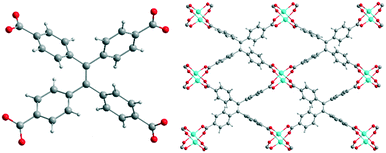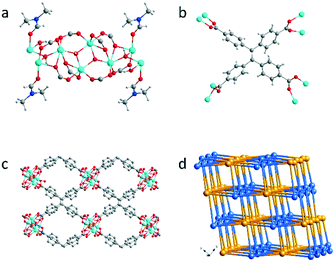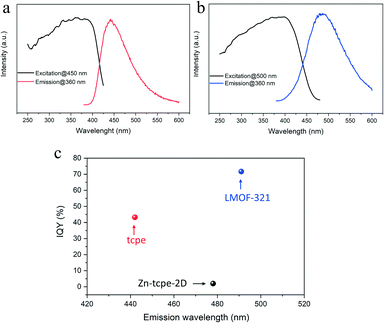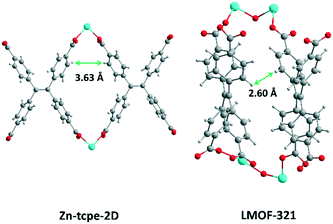Enhanced fluorescence by increasing dimensionality: a novel three-dimensional luminescent metal–organic framework with rigidified ligands†
Yuhan
Lin‡
a,
Liang
Yu‡
a,
Hao
Wang
 *a and
Jing
Li
*a and
Jing
Li
 *ab
*ab
aHoffmann Institute of Advanced Materials, Shenzhen Polytechnic, 7098 Liuxian Blvd., Nanshan District, Shenzhen, Guangdong 518055, China. E-mail: wanghao@szpt.edu.cn
bDepartment of Chemistry and Chemical Biology, Rutgers University, 123 Bevier Road, Piscataway, NJ 08854, USA. E-mail: jingli@rutgers.edu
First published on 1st September 2020
Abstract
We show that photoluminescence quantum yields (PLQYs) of chromophore-incorporated MOFs can be improved substantially by increasing their structural dimensionality. A novel 3D zinc-based metal–organic framework built on tetrakis(4-carboxyphenyl)ethylene has been developed and its fluorescence compared with that of the 2D parent structure.
Strongly luminescent solids attract tremendous interest as they possess potential for applications in light-emitting devices and chemical/biological sensing.1–4 Organic chromophores exhibiting aggregation-induced emission (AIE) behaviour are particularly interesting due to their unique luminescence properties.5 AIE chromophores show little or no emission in dilute solutions but are highly emissive upon concentration or solidification. Tetraphenylethylene (tpe) is a typical and simple AIE-type chromophore. It is non-emissive in dilute solutions, but becomes brightly emissive with 50% internal quantum yield (IQY) in the solid state.6 This is because in tpe aggregates, short intermolecular interactions prevent the fast rotation of the terminal phenyl rings and twisting of the C
![[double bond, length as m-dash]](https://www.rsc.org/images/entities/char_e001.gif) C bonds which would otherwise quench its fluorescence, such as in dilute solutions.
C bonds which would otherwise quench its fluorescence, such as in dilute solutions.
Over the past several years, extensive efforts have been made to rigidify AIE type chromophores within metal–organic frameworks (MOFs) through coordination to metal ions. Such an approach has proven to be an alternative and often more efficient way to enhance the fluorescence of the molecular chromophores.7–14 It has been found in most cases the MOFs made of such chromophore-based ligands show higher quantum efficiency. It is generally recognized that, immobilization of these chromophores onto the MOF structures limit the molecular vibrations, torsions, and rotations which may result in nonradiative excitation decay in the molecular chromophores. However, the framework will have little or no improvement if the chromophore ligands are not effectively immobilized within the MOF. Fluorescent properties of MOFs may be influenced by various factors.15–17 Here we show that the quantum yields of AIE chromophore-based MOFs are highly dependent on their dimensionality, which is directly associated with the barrier of the molecular rotations or torsions.
Tetrakis(4-carboxyphenyl)ethylene (tcpe) is a simple tetracarboxylate ligand obtained by functionalizing tpe. Under UV (360 nm) excitation, solid tcpe emits blue light with an emission maximum at 442 nm, and an internal quantum yield (IQY) of 43.2% (Fig. 3). Zn2+ has been commonly used as an anchor to immobilize AIE-type chromophores in MOFs due to its d10 electronic configuration, which would not interfere the luminescence-related electron transfer processes on the organic chromophores.7,8 Dincă et al. reported a two-dimensional (2D) MOF structure built on Zn2+ and tcpe (denoted as Zn-tcpe-2D, Fig. 1), which has a low quantum yield of only 2.0%.18,19 The authors concluded that the rotation of the phenyl rings in tcpe molecules is not completely shut off in the 2D MOF, which leads to substantially quenched emission of the MOF compared to the tcpe chromophore. In this context, it is interesting to explore if a three-dimensional (3D) structure would firmly anchor the chromophore and limit the rotation of phenyl rings. Thus we attempted to develop a 3D MOF structure built on Zn2+ and tcpe. Such structures have not been reported so far. We found that solvothermal synthesis with common solvent systems (DMF/alcohols/water) resulted in either amorphous products or Zn-tcpe-2D. This indicates that planar tcpe may favor the 2D layered structure with Zn. To increase the framework dimensionality, we then tried larger templates in the synthesis, aiming at 3D structures. Using pyrazine as a template, we succeeded in synthesizing a novel 3D LMOF structure built on Zn2+ and tcpe. It should be pointed out that the pyrazine used in this approach serve as a template or modulator, and is not incorporated in the crystal structure of the luminescent MOF.
 | ||
| Fig. 1 Molecular structure of H4tcpe chromophore (left) and Zn-tcpe-2D (right). Zn: cyan, O: red, C: grey, H: white. Terminal water molecules are omitted for clarity. | ||
The title compound was synthesized solvothermally by mixing ZnCl2, H4tcpe, and pyrazine in DMF/H2O at 85 °C for 2 days (see ESI† for synthesis details). Its crystal structure was determined by single-crystal X-ray diffraction analysis. The new MOF, termed as LMOF-321, has a formula of [Zn3(μ3-OH)2(tcpe)](DMF)(H2O). LMOF-321 crystallizes in the triclinic crystal system with a space group of P![[1 with combining macron]](https://www.rsc.org/images/entities/char_0031_0304.gif) . Each zinc ion is octahedrally coordinated to six oxygen atoms from ligand carboxylates, bridging hydroxyl, and terminal solvents (water or DMF), forming one-dimensional (1D) chains which are further interconnected by tcpe. The resultant 3D structure possesses 1D open channels along the a-axis (Fig. 2c). Topology analysis reveals LMOF-321 adopts fsc type structure (Fig. 2d). Powder X-ray diffraction (PXRD) measurements confirmed the phase purity of LMOF-321 (Fig. S1†). Thermogravimetric analysis (TGA) reveals a weight losses of 20% before 200 °C which is corresponding to the coordinated and free solvents inside the pore (Fig. S2†).
. Each zinc ion is octahedrally coordinated to six oxygen atoms from ligand carboxylates, bridging hydroxyl, and terminal solvents (water or DMF), forming one-dimensional (1D) chains which are further interconnected by tcpe. The resultant 3D structure possesses 1D open channels along the a-axis (Fig. 2c). Topology analysis reveals LMOF-321 adopts fsc type structure (Fig. 2d). Powder X-ray diffraction (PXRD) measurements confirmed the phase purity of LMOF-321 (Fig. S1†). Thermogravimetric analysis (TGA) reveals a weight losses of 20% before 200 °C which is corresponding to the coordinated and free solvents inside the pore (Fig. S2†).
 | ||
| Fig. 2 Coordination modes of Zn2+ (a) and tcpe4− (b) of LMOF-321. (c) 3D structure view and (d) drawing of the fsc topological structure of LMOF-321. | ||
Optical properties of LMOF-321 was investigated and compared with that of the organic chromophore and Zn-tcpe-2D. LMOF-321 emits at 485 nm under 360 nm excitation (Fig. 3b). Its emission wavelength is similar to that of Zn-tcpe-2D, and is at a notably lower energy compared to that of the pristine chromophore (emits at 442 nm). Such an emission energy shift has been commonly observed for LMOFs with the incorporation of organic chromophores.10,12,20 Previous calculations indicate that the large red or blue shift of emission upon immobilization of a ligand into a MOF structure is often attributed to the breakdown or reformation of the delocalized conjugation system.13 The IQY of LMOF-321 was measured at room temperature and the value is 71.7% at 360 nm excitation wavelength. Compared to the IQY of the organic chromophore H4tcpe (43.2%), the increase of 66.0% for LMOF-321 represents a substantial improvement. Notably, the IQY enhancements are 34 times for LMOF-321 over Zn-tcpe-2D (IQY: 2%). The much lower quantum efficiency of Zn-tcpe-2D than that of the pristine organic chromophore H4tcpe itself was attributed to the rotation of the phenyl rings. It was surmised that the rotation of the phenyl rings is not completely shut off upon incorporation of the organic chromophore in the 2D layered structure, and thus causes the quenching of the fluorescence. In comparison, the remarkably high quantum yields of LMOF-321 is clearly a result of rigidifying the organic chromophores in the 3D structures, which limits the molecular motions including vibrations, torsions, and rotations, and thus reduces the nonradioactive excitation decay.
 | ||
| Fig. 3 Optical properties of the ligand and LMOFs. Excitation and emission spectra of H4tcpe (a), LMOF-321 (b), and comparison of emission wavelength and IQY for H4tcpe, Zn-tcpe-2D and LMOF-321 (c). | ||
To confirm our hypothesis, we had a detailed comparison of the crystal structures of LMOF-321 with that of Zn-tcpe-2D, and found that the spatial separation between the closest tpe cores in LMOF-321 is noticeably smaller than that in Zn-tcpe-2D. As demonstrated in Fig. 4, the shortest H⋯H distances between the nearest phenyl rings, a parameter often referred to in connection with AIE chromophores,5 is 2.60 Å in LMOF-321. The contact is more than 1 Å shorter than that in Zn-tcpe-2D which is as large as 3.63 Å. This confirms that the phenyl rings in tcpe become more closely packed from 2D layered structure to the 3D framework, and thus shut off the possible rotations of the phenyl rings. To the best of our knowledge, this represents the first example showing a substantial improvement in the quantum yields of LMOFs by increasing the dimensionality of the MOF structures. This is not unexpected as in the 3D structure, the organic chromophore molecules are more rigidified leading to higher luminescent efficiency, as observed in other luminescent MOFs.13
Conclusions
In conclusion, we have successfully developed a novel Zn-based LMOF by rigidifying an organic chromophore H4tcpe into a MOF backbone. Using a suitable template in our synthesis, we successfully assembled H4tcpb and Zn2+ into a 3D network that effectively restricted molecular motions of the ligand, including the rotation of phenyl rings. As a result, the luminescence internal quantum yield of the resultant LMOF-321 is boosted by 34 times over the previously reported 2D layered structure made of the same metal and ligand, Zn-tcpe-2D, confirming the effectiveness of this approach. This work serves as the first example demonstrating luminescence enhancement by increasing structural dimensionality, which may provide insight for future design of high performance LMOFs for real-world applications.Conflicts of interest
There are no conflicts to declare.Acknowledgements
We thank the National Natural Science Foundation of China (No. 21901166), Natural Science Foundation of Guangdong Province (No. 2019A1515010692), Shenzhen Science and Technology Innovation Commission (No. JCYJ20190809145615620) for financial support.Notes and references
- N. Bardsley, S. Bland, M. Hansen, L. Pattison, M. Pattison, K. Stober and M. Yamada, Solid State Lighting R&D Plan, U.S. Department of Energy, Washington, DC, 2015 Search PubMed.
- Q.-Y. Li, Z. Ma, W.-Q. Zhang, J.-L. Xu, W. Wei, H. Lu, X. Zhao and X.-J. Wang, Chem. Commun., 2016, 52, 11284–11287 RSC
.
- S. Pimputkar, J. S. Speck, S. P. DenBaars and S. Nakamura, Nat. Photonics, 2009, 3, 180–182 CrossRef CAS
.
- L. Yin, L. Yang, W. Yang, Y. Guo, K. Ma, S. Li and J. Zhang, Solid-State Electron., 2010, 54, 1520–1524 CrossRef CAS
.
- Y. Hong, J. W. Y. Lam and B. Z. Tang, Chem. Soc. Rev., 2011, 40, 5361–5388 RSC
.
- Y. Hong, J. W. Y. Lam and B. Z. Tang, Chem. Commun., 2009, 4332–4353 RSC
.
- Q. Gong, Z. Hu, B. J. Deibert, T. J. Emge, S. J. Teat, D. Banerjee, B. Mussman, N. D. Rudd and J. Li, J. Am. Chem. Soc., 2014, 136, 16724–16727 CrossRef CAS
.
- Z. Hu, G. Huang, W. P. Lustig, F. Wang, H. Wang, S. J. Teat, D. Banerjee, D. Zhang and J. Li, Chem. Commun., 2015, 51, 3045–3048 RSC
.
- B. Jiang, C.-W. Zhang, X.-L. Shi and H.-B. Yang, Chin. J. Polym. Sci., 2019, 37, 372–382 CrossRef CAS
.
- W. P. Lustig and J. Li, Coord. Chem. Rev., 2018, 373, 116–147 CrossRef CAS
.
- W. P. Lustig, S. Mukherjee, N. D. Rudd, A. V. Desai, J. Li and S. K. Ghosh, Chem. Soc. Rev., 2017, 46, 3242–3285 RSC
.
- W. P. Lustig, F. Wang, S. J. Teat, Z. Hu, Q. Gong and J. Li, Inorg. Chem., 2016, 55, 7250–7256 CrossRef CAS
.
- Z. Wei, Z.-Y. Gu, R. K. Arvapally, Y.-P. Chen, R. N. McDougald, J. F. Ivy, A. A. Yakovenko, D. Feng, M. A. Omary and H.-C. Zhou, J. Am. Chem. Soc., 2014, 136, 8269–8276 CrossRef CAS
.
- W. P. Lustig, Z. Shen, S. J. Teat, N. Javed, E. Velasco, D. M. O'Carroll and J. Li, Chem. Sci., 2020, 11, 1814–1824 RSC
.
- A. Karmakar, P. Samanta, S. Dutta and S. K. Ghosh, Chem. – Asian J., 2019, 14, 4506–4519 CrossRef CAS
.
- P. Samanta, A. V. Desai, S. Sharma, P. Chandra and S. K. Ghosh, Inorg. Chem., 2018, 57, 2360–2364 CrossRef CAS
.
- N. Yanai, K. Kitayama, Y. Hijikata, H. Sato, R. Matsuda, Y. Kubota, M. Takata, M. Mizuno, T. Uemura and S. Kitagawa, Nat. Mater., 2011, 10, 787–793 CrossRef CAS
.
- N. B. Shustova, B. D. McCarthy and M. Dincă, J. Am. Chem. Soc., 2011, 133, 20126–20129 CrossRef CAS
.
- N. B. Shustova, T.-C. Ong, A. F. Cozzolino, V. K. Michaelis, R. G. Griffin and M. Dincă, J. Am. Chem. Soc., 2012, 134, 15061–15070 CrossRef CAS
.
- L. Yu, H. Wang, W. Liu, S. J. Teat and J. Li, Cryst. Growth Des., 2019, 19, 6850–6854 CrossRef CAS
.
Footnotes |
| † Electronic supplementary information (ESI) available. CCDC 1984426. For ESI and crystallographic data in CIF or other electronic format see DOI: 10.1039/d0ce01092h |
| ‡ These two authors contributed equally to this work. |
| This journal is © The Royal Society of Chemistry 2020 |

